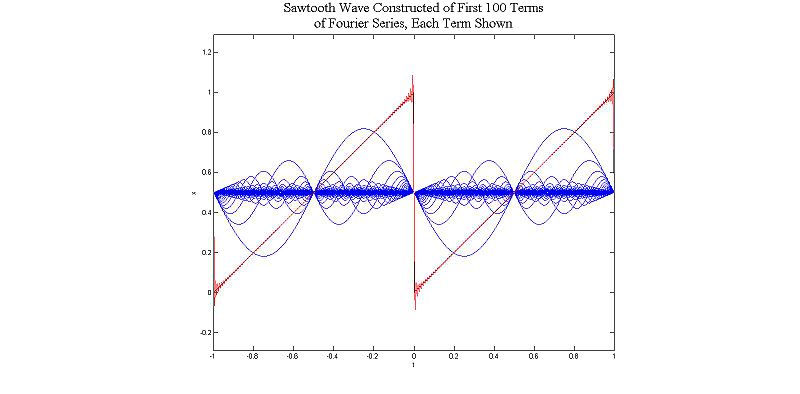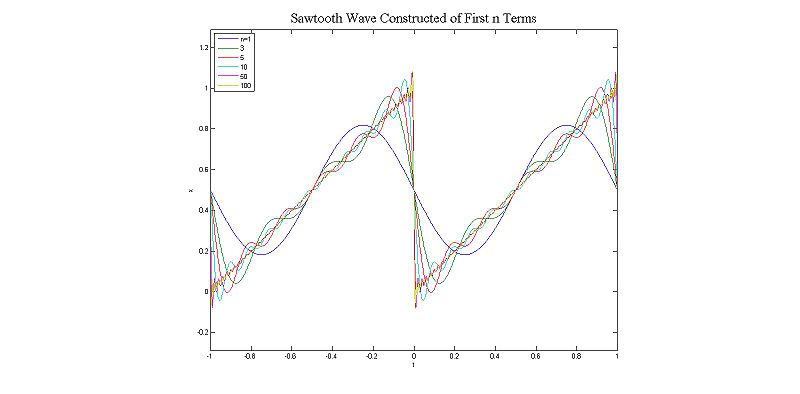Exercise: Sawtooth Redone With Exponential Basis Functions: Difference between revisions
John.hawkins (talk | contribs) (First bit of work) |
Gary.starr (talk | contribs) No edit summary |
||
| (4 intermediate revisions by 2 users not shown) | |||
| Line 19: | Line 19: | ||
<br /> |
<br /> |
||
<center><math>x(t)=\sum_{-\infty}^\infty a_n e^{j2\pi nt/T}</math></center> |
<center><math>x(t)=\sum_{n=-\infty}^\infty a_n e^{j2\pi nt/T}</math></center> |
||
<br /> |
<br /> |
||
| Line 31: | Line 31: | ||
<br /> |
<br /> |
||
Noting |
Noting that our period for this function is <math>T=1</math> and that an obvious choice for <math>c</math> is zero, we proceed: |
||
<br /> |
<br /> |
||
| Line 41: | Line 41: | ||
<br /> |
<br /> |
||
For <math>n\neq 0</math>, the above integral is solved easiest using integration by parts. When <math>\ n=0</math>,however, IBP does not work, so the case when <math>\ n=0</math> needs to be considered separately. In this case, |
|||
<br /> |
<br /> |
||
| Line 47: | Line 47: | ||
<br /> |
<br /> |
||
For <math>n\neq 0</math>, |
For <math>n\neq 0</math>, we continue with IBP, letting |
||
<br /> |
<br /> |
||
| Line 61: | Line 61: | ||
<br /> |
<br /> |
||
This gives |
|||
we have |
|||
<br /> |
<br /> |
||
| Line 67: | Line 67: | ||
<math>a_n=t\left(\frac{1}{-j2\pi n}\right)e^{-j2\pi nt}\Bigg|_0^1-\int_0^1\left(\frac{1}{-j2\pi n}\right)e^{-j2\pi nt}dt</math> |
<math>a_n=t\left(\frac{1}{-j2\pi n}\right)e^{-j2\pi nt}\Bigg|_0^1-\int_0^1\left(\frac{1}{-j2\pi n}\right)e^{-j2\pi nt}dt</math> |
||
<br /> |
|||
<math>=\left[\frac{1}{-j2\pi n}e^{-j2\pi n}-0\right]-\left(\frac{1}{-j2\pi n}\right)^2e^{-j2\pi nt}\Bigg|_0^1</math> |
|||
<br /> |
|||
<math>=\frac{1}{-j2\pi n}e^{-j2\pi n}-\left(\frac{1}{-j2\pi n}\right)^2\left(e^{-j2\pi n}-1\right)</math> |
|||
</center> |
|||
<br /> |
|||
But |
|||
<br /> |
|||
<center> |
|||
<math>\ e^{-j2\pi n}=\cos(-2\pi n)+j\sin(-2\pi n) = 1+j0=1</math> |
|||
</center> |
|||
<br /> |
|||
So |
|||
<br /> |
|||
<center> |
|||
<math>a_n=\frac{1}{-j2\pi n}(1)-\left(\frac{1}{-j2\pi n}\right)^2(1-1)=\frac{1}{-j2\pi n}</math> |
|||
</center> |
|||
<br /> |
|||
Therefore, |
|||
<br /> |
|||
<center><math>x(t)=\frac{1}{2}-\sum_{n=\pm 1}^{\pm \infty}\frac{1}{j2\pi n}e^{j2\pi nt}</math></center> |
|||
<br /> |
|||
==Solution Graphs== |
|||
I modified the Matlab code used in the [[Exercise: Sawtooth Wave Fourier Transform]] to generate the solution graphs using the equation found above instead of the previously found solution. This code can be found here: [[Sawtooth2 Matlab Code]]. It generates the following analagous three graphs, which as hoped appear exactly identical to those found using the other method. Note that the "terms" mentioned in the titles of the graphs should now be interpreted as the sum of the <math>n</math>th and <math>-n</math>th terms. |
|||
<br /> |
|||
[[Image:Sawtooth2_First_100_Terms.jpg|thumb|800px|center]] |
|||
<br /> |
|||
[[Image:Sawtooth2_First_n_Terms.jpg|thumb|800px|center]] |
|||
<br /> |
|||
[[Image:Sawtooth2_Error.jpg|thumb|800px|center]] |
|||
<br /> |
|||
==Analytical Comparison of Two Solutions== |
|||
To convince myself that the two solutions are actually the same, I performed the following analysis. Let <math>t_n</math> be the nth term of the solution found on this page. Then for <math>n\neq 0</math>, |
|||
<br /> |
|||
<center> |
|||
<math>t_n+t_{-n}=\frac{1}{-j2\pi n}e^{j2\pi nt}+\frac{1}{-j2\pi (-n)}e^{j2\pi (-n)t}</math> |
|||
<br /> |
|||
<math>=\frac{1}{-j2\pi n} (\cos 2\pi nt+j\sin 2\pi nt)-\frac{1}{-j2\pi n}\left(\cos(-2\pi nt)+j\sin(-2\pi nt)\right)</math> |
|||
<br /> |
|||
<math>=\frac{1}{-j2\pi n}\left(\cos 2\pi nt+j\sin 2\pi nt-\cos 2\pi nt+j\sin 2\pi nt \right)</math> |
|||
<br /> |
|||
<math>=\frac{1}{-j2\pi n}\left(2j\sin 2\pi nt\right)</math> |
|||
<br /> |
|||
<math>=-\frac{1}{\pi n}\sin 2\pi nt</math> |
|||
</center> |
|||
<br /> |
|||
Therefore, |
|||
<br /> |
|||
<center><math>x(t)=\frac{1}{2}-\sum_{n=\pm 1}^{\pm \infty}\frac{1}{j2\pi n}e^{j2\pi nt}=\frac{1}{2}-\sum_{n=1}^\infty\frac{1}{\pi n}\sin 2\pi nt</math></center> |
|||
<br /> |
|||
As we had hoped and expected. |
|||
<br /> |
|||
==Reviewed By== |
|||
[[Lau, Chris|Christopher Garrison Lau I]] |
|||
Tyler Starr |
|||
==Read By== |
|||
==Comments== |
|||
Latest revision as of 13:18, 25 January 2010
Author
John Hawkins
Problem Statement
Find the Fourier Tranform with exponential basis functions of the sawtooth wave given by the equation
Note that this is the same function solved in Exercise: Sawtooth Wave Fourier Transform, but solved differently to compare the two methods.
Solution
The goal of this method is to find the coefficients such that
In class we showed not only that this was possible, but also that
Noting that our period for this function is and that an obvious choice for is zero, we proceed:
For , the above integral is solved easiest using integration by parts. When ,however, IBP does not work, so the case when needs to be considered separately. In this case,
For , we continue with IBP, letting
This gives
But
So
Therefore,
Solution Graphs
I modified the Matlab code used in the Exercise: Sawtooth Wave Fourier Transform to generate the solution graphs using the equation found above instead of the previously found solution. This code can be found here: Sawtooth2 Matlab Code. It generates the following analagous three graphs, which as hoped appear exactly identical to those found using the other method. Note that the "terms" mentioned in the titles of the graphs should now be interpreted as the sum of the th and th terms.
Analytical Comparison of Two Solutions
To convince myself that the two solutions are actually the same, I performed the following analysis. Let be the nth term of the solution found on this page. Then for ,
Therefore,
As we had hoped and expected.
Reviewed By
Tyler Starr













![{\displaystyle =\left[{\frac {1}{-j2\pi n}}e^{-j2\pi n}-0\right]-\left({\frac {1}{-j2\pi n}}\right)^{2}e^{-j2\pi nt}{\Bigg |}_{0}^{1}}](https://wikimedia.org/api/rest_v1/media/math/render/svg/e7c9ab7d1566eab3870d23993660797c53f16631)















